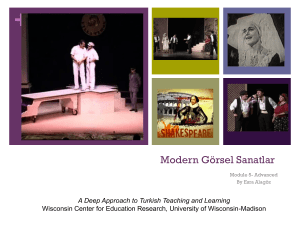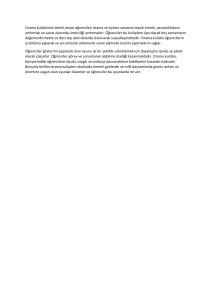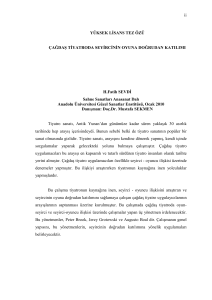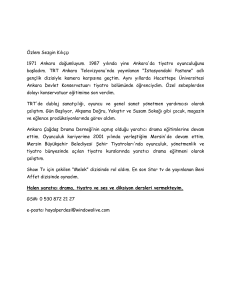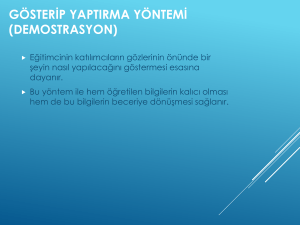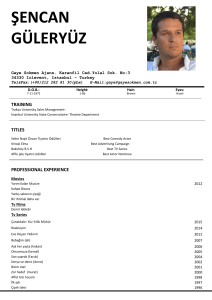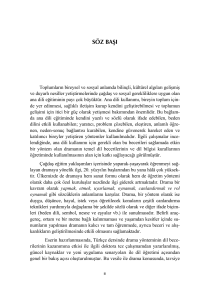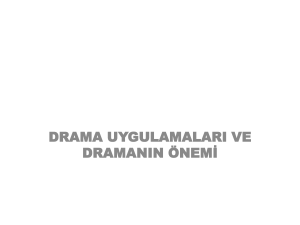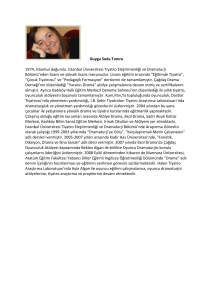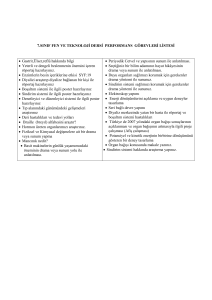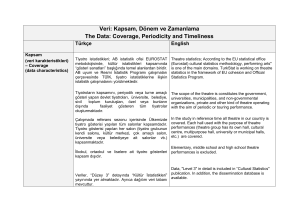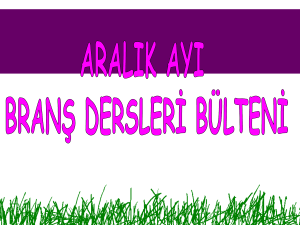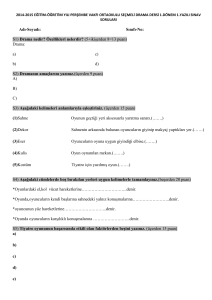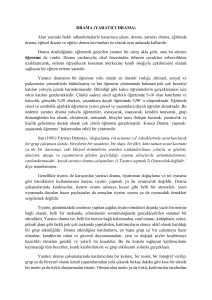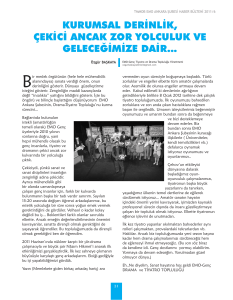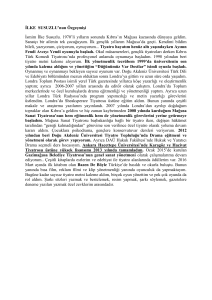Adlandırmayı Değiştirmeyelim
advertisement
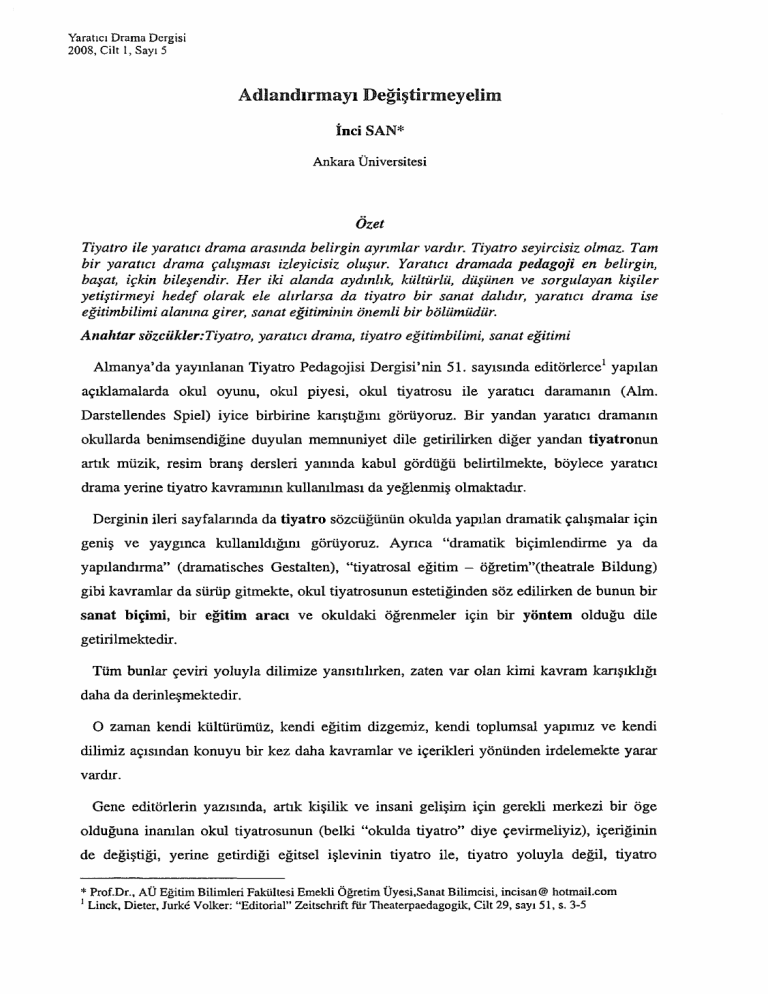
Yaratıcı Drama Dergisi 2008, Cilt I, Sayı 5 Adlandırmayı Değiştirmeyelim İnci SAN* Ankara Üniversitesi Özet Tiyatro ile yaratıcı drama arasında belirgin ayrımlar vardır. Tiyatro seyircisiz olmaz. Tam bir yaratıcı drama çalışması izleyicisiz oluşur. Yaratıcı dramada pedagoji en belirgin, başat, içkin bileşendir. Her iki alanda aydınlık, kültürlü, düşünen ve sorgulayan kişiler yetiştirmeyi hedef olarak ele alırlarsa da tiyatro bir sanat dalıdır, yaratıcı drama ise eğitimbilimi alanına girer, sanat eğitiminin önemli bir bölümüdür. Anahtar sözcükler:Tiyatro, yaratıcı drama, tiyatro eğitimbilimi, sanat eğitimi Almanya’da yayınlanan Tiyatro Pedagojisi Dergisi’nin 51. sayısında editörlerce1yapılan açıklamalarda okul oyunu, okul piyesi, okul tiyatrosu ile yaratıcı daramamn (Alm. Darstellendes Spiel) iyice birbirine karıştığını görüyoruz. Bir yandan yaratıcı dramanm okullarda benimsendiğine duyulan memnuniyet dile getirilirken diğer yandan tiyatronun artık müzik, resim branş dersleri yanında kabul gördüğü belirtilmekte, böylece yaratıcı drama yerine tiyatro kavramının kullanılması da yeğlenmiş olmaktadır. Derginin ileri sayfalarında da tiyatro sözcüğünün okulda yapılan dramatik çalışmalar için geniş ve yaygınca kullanıldığım görüyoruz. Ayrıca “dramatik biçimlendirme ya da yapılandırma” (dramatisches Gestalten), “tiyatrosal eğitim - öğretim”(theatrale Bildung) gibi kavramlar da sürüp gitmekte, okul tiyatrosunun estetiğinden söz edilirken de bunun bir sanat biçimi, bir eğitim aracı ve okuldaki öğrenmeler için bir yöntem olduğu dile getirilmektedir. Tüm bunlar çeviri yoluyla dilimize yansıtılırken, zaten var olan kimi kavram karışıklığı daha da derinleşmektedir. O zaman kendi kültürümüz, kendi eğitim dizgemiz, kendi toplumsal yapımız ve kendi dilimiz açısından konuyu bir kez daha kavramlar ve içerikleri yönünden irdelemekte yarar vardır. Gene editörlerin yazısında, artık kişilik ve insani gelişim için gerekli merkezi bir öge olduğuna inanılan okul tiyatrosunun (belki “okulda tiyatro” diye çevirmeliyiz), içeriğinin de değiştiği, yerine getirdiği eğitsel işlevinin tiyatro ile, tiyatro yoluyla değil, tiyatro * Prof.Dr., AÜ Eğitim Bilimleri Fakültesi Emekli Öğretim Üyesi,Sanat Bilimcisi, incisan® hotmail.com 1 Linck, Dieter, Jurke Volker: “Editorial” Zeitschrift für Theaterpaedagogik, Cilt 29, sayı 51, s. 3-5 104 İnci SAN içinden, tiyatro yaparak gerçekleştiği ileri sürülmekte ve bunun sanatsal-uygulamalı tiyatro oynamak demek olduğu belirtilmektedir. Pedagoji karşısında estetik, pedagojiye karşın estetik gibi tartışmaların da son bulduğu eklenip, estetik tiyatro pratiğinin eğitimsel olduğu vurgulanmaktadır. Doğal olarak bu arada tiyatronun resim, müzik, dil, video, medya, spor ve dansı birleştirdiği de unutulmamalıdır denilmektedir. (Schul) theaterkunst kavramına da yer veriliyor ki, çevirisi "okul tiyatrosu sanatı” olmaktadır. Aym dergide Joachim Reiss “okul içi tiyatro sanatının” estetik eğitimi dışında, diğer alanlardaki önemine dikkat çekmekte ve onu okul dışı kültürel çalışmalardan ayrı tutmaktadır. Gene söz konusu dergide “Fokus - Okul Tiyatrosu” yayınında bu son gelişmelerde artık okul tiyatrosunun devlet ve şehir tiyatrolarını mı etkilediğini yoksa tersi mi olduğunun sorulduğu belirtilmektedir. Okulda yaratıcı drama yerine okul tiyatrosu kavramının öne sürülmesinin nedeni olarak da, alanın ana temelinin, çekirdeğinin tiyatro olduğunun geç de olsa belirtilmesi gerekliliği savlanmaktadır. Alanın öğreticisi olan öğretmen de oyun lideri, tiyatro pedagogu filan değil, tiyatro öğretmenidir denmektedir.2 Schiller’e dayanan ve oyun’u temel alan görüşün bunca yıldır sürdürülen görüşlerde değişerek günümüze geldiği varsayılarak, esas yapılanın bal gibi tiyatro olduğu vurgulanmaktadır. Tüm bu ileri sürülenlere, okulda tiyatro alanı için Öğretmen yetiştiren üniversite programlarının henüz çok az olduğunun belirtilmesi eklenmektedir. Bu arada okulda tiyatronun profesyonel tiyatro olmadığı, amatör tiyatro da olmadığı vurgulanırken, amatör tiyatroda oyuncuların oyunculuk eğitimi almamış oldukları kısaca alan dışından oldukları belirtilmekte, buna karşın okul tiyatrosunda öğrencilerin tiyatro açısından eğitildikleri ileri sürülmektedir. Çünkü öğrenciler ortaya çıkardıkları ya da üzerinde çalıştıkları ürünü açıkça (kamu önünde) sahnelemektedirler. Hatta Almanya’da kimi eyaletlerde tiyatro dalında “Abitur" (olgunluk sınavı) bile yapabilmektedirler. İngilizceden olgunluk sınavını veren bir öğrenciye amatör denemeyeceğine göre.... Şöyle sürmektedir yazı: “Önceden eğitim almamış olanların yaptığı tiyatroya amatör tiyatro deniyorsa, kuşkusuz öğrenciler de amatördür. Ancak hepsi de örgütlü (örgün) tek bir çatı altodadırlar: Okul. Öğrenci olmayan biri okul tiyatrosunda yer alamaz. Okul tiyatrosu okulun içindedir. Ve kendi estetiği vardır. Bu estetiği eğitimsel, yetişimsel süreçlerden alır. Aynca okul tiyatrosu 2 Nitekim denmektedir, Almanca öğretmenine de Almanca pedagogu demiyoruz (!). YAZ 2008, CİLT1, SAYI 5 ADLANDIRMAYI DEĞİŞTİRMEYELİM 105 gruplan yaşça birbirine yakın bireylerden kuruludur. Okul tiyatrosu kendine özgü bir sanat ortaya koyar.”3 Şimdi tüm bu görüşlere ülkemiz ve bunca yıllık yaratıcı drama çalışmalarımız (kuramsal, uygulamalı ve kılgısal olmak üzere) açısından bakarsak: Neden biz başlangıçta (1980’li yılların hemen başında) okulda ya da eğitimde tiyatro demedik? Her şeyden önce yaratıcı dramayı örgün eğitimde ve tiyatro oyuncusu yetiştirilmesinde yararlanılacak çok önemli bir alan olarak gördük. Amaç çok yönlü yaratıcı bir eğitimle, bedensel, zihinsel ve sanatsal gelişmeye yol açacak; eğitim dizgesinde sıklıkla yer alan bilişsel, duyuşsal ve devinimsel açıdan yetişmeyi de sağlayarak çok önem verdiğimiz aydmlanmacı ve kültürlü insanın kendini yaratması için ona geniş ufukları açmaktı. Kuşkusuz bu çalışmaları, pedagojik ve gelişim psikolojisi açılarından her yaş grubuna göre programlamak gerekmekteydi. 80’li yıllarda alana en çok ilgi gösteren okul-öncesi eğitimcileri herhalde çocuklarla tiyatro yapmıyorlardı. Seminerlerimize (1985’den başlayarak iki yılda bir düzenlenen seminerler) gelen başlıca İngiliz ve Alman uzmanlar, okuduğumuz Anglo Amerikan ve Alman yayınlan bize yaratıcı drama ile tiyatroyu ayırmamız yönünde işaretler veriyorlardı.Doğal olarak tiyatro bilgilerine, özel olarak oyunculuğa hazırlık tekniklerine ve öğretilerine gereksinmemiz vardı, ama oyuncu yetiştirmiyorduk. Şimdi sözü geçen Alman dergisi neden adı Tiyatro Pedagojisi olup alt başlığı da Okulda Yaratıcı Drama iken, bu alt başlığı değiştirip “Okulda Tiyatro” yapıyordu? 52. sayısının alt başlığı da Tiyatro yapmak - Oynamak —Öğretmek olmuştur. Almanya açısından yanıt açıktır; hatta belki bunu Avrupa için de ileri sürebiliriz: Antik dönemlerden başlayarak gelenekselleşen klasik tiyatro ya da dram sanatı bu toplumlarda köklü bir yapıya sahiptir. Tiyatronun, hangi açıdan ele alınırsa alınsın, çocuğa, gence kısaca kişiye bir zarar getireceği gibi bir görüş, kimi olumsuz fanatik zihniyetlerin egemen olduğu belli dönemler dışında, toplumda yer almamıştır. Ya da şöyle söyleyelim: O dönemlerin tortusu zaman zaman kimi gene fanatik görüşlerde kendini belli etse de, en azından eğitimli ve kültürlü kesimlerde tiyatroya olumsuzca yaklaşılmaz. Belki şu kısa bilgiler ışığında da ülkemizle bir kıyaslama yapabiliriz. Almanya’nın büyük eyaletlerinden Hessen’de, ASSÎTEJ ile Hessen Kültür Bakanlığı ve Hessen Bilim ve Sanat Bakanlığının, Hessen Okul Tiyatrosu Eyalet Birliğinin de danışmanlığında düzenlenen bir 3 Linck, D., Jurke, V., a.g.y. s. 4 YARATICI DRAMA DERGİSİ 106 İnci SAN araştırma4 gerçekleştirilmiştir. Yaratıcı dramamn giderek eyaletteki gelişmesi ve profesyonel tiyatroya taleplerin artması dolayısıyla tiyatro ile okuFun işbirliği sorgulanmıştır. Sonuçlar şöyledir: Eyaletteki tüm okullara gönderilen ankete % 52 katılım olmuştur. Sayı 1060’dır. Bu okulların % 90’ı okullarında tiyatro etkinliklerinin bulunduğunu, % 79’u düzenli olarak okulun bir ya da iki tiyatroya gittiğini; % 87’si okullarında yaratıcı drama çalışmalarına yer verildiğini; yaratıcı dramamn değişik eğitim öğretim aşamalarında zorunlu seçimlik ya da ileri bir sımfta zorunlu olarak yer alması yanında okul tiyatrosunda oynama konusunda % 88 gibi bir yüzdeye erişildiği; % 79 oranında da okullarda derslerde drama yönteminin yer aldığı; profesyonel tiyatroları izlemenin ilköğretim aşamasında en çok yüzdeye sahip olduğu, gidilen tiyatronun da % 90 çocuk ve genç tiyatrosu olduğu; % 38 oranında yetişkin tiyatrosu, % 30 oranında opera ve az sayıda okulun da dans tiyatrosuna gittikleri; anketi yanıtlayan okulların üçte bir oranında, 320’sinde bir drama öğretmeni bulunduğu; tüm gün eğitim veren ilköğretim okullarının % 86’sının okullarına tiyatroları düzenli olarak davet ettikleri biçiminde yanıtlar alınmıştır5. Yukarıdaki oranlar yalnızca bir eyaletin okul ile tiyatro ve yaratıcı drama ilişkisini ortaya koymaktadır. O zaman okul ve tiyatro, eğitim ve tiyatro gibi bir başlık, yaratıcı dramadan ayrı olarak, doğaldır ki geçerlidir, üzerinde çalışılabilir. Yaratıcı drama ayrıdır, evet, ama tiyatrolarla sık sık karşı karşıya gelen öğrenci, yaratıcı dramaya da yatkın, istekli olacak, amaçlanan hedefe de daha bir başarıyla yaklaşacaktır. Son olarak, özellikle ülkemizdeki durumu da göz önüne alarak (tiyatronun izlenebilme yaygınlığının çok az olması; çocuk ve genç tiyatrolarının sayıca pek az olması; genel olarak sanat ve kültüre ilgi, yatırım, eğitimde yer verme açılarından var olan yoksulluğumuz, vd.) asıl konuya dönecek olursak, sanırım yaratıcı drama ile tiyatro bakımından can alıcı şu iki ayırt edici noktayı vurgulamak isterim: 1. Tiyatro seyircisiz olmaz (Tam bir yaratıcı drama çalışması izleyicisiz oluşur.), 2. Yaratıcı dramada pedagoji en belirgin, başat, içkin bileşendir (Her iki alanın en geniş anlamda amaçları aynı gibi görünse de, ikisinde de estetik, haz alma, paylaşma, öğrenme gibi pek çok ortak payda bulunsa da...). 4 [email protected] Tiyatro Pedagojisi Dergisi, sayı 52, Hannover 2008, s. 58-60 5 Sözü edilen anketin bu yazıyı doğrudan ilgilendirmediğini düşündüğüm için diğer sonuçlarına yer verilmemiştir. YAZ 2008, CİLT1, SAYI 5 ADLANDIRMAYI DEĞİŞTİRMEYELİM 107 Her iki alan arasında kuramsal boyutta, ilişkiyi irdeleyip belli sonuçlara varabilecek olan tiyatro eğitimbilimi, tiyatro pedagojisidir6 Bu alanın eğitbilim ve tiyatrobilimi programlarında yer alması gecikmemelidir. 6 Bu konuda bkz.: San, İnci. “Tiyatroya Rağmen Yaratıcı Drama”, Çağdaş Drama Demeği,Yaratıcı Drama Dergisi,Cilt 1, Sayı 1, 2006, s. 5-13 YARATICI DRAMA DERGİSİ Creative Drama Jouma! 2008, Volüme 1, Issue 5 Let Us Not Modify the Terminology** tnci SAN’ Ankara University Abstract There are distinctive differences between theaîre and Creative drama. Theatre cannoî exist without an audience. An exact Creative drama work is without an audience. Education is the most distinctive, dominant, and inherent component o f Creative drama. Although both aim to enlighten, cultivate and train thinking and questioning people, theatre is a branch of art; whereas Creative drama belongs to education sciences and is an important part ofarts education. Keywords: Theatre, Creative drama, theatre education studies, art education In the 51sl issue of Zeitschrift für Theaterpaedagogik (Journal of Theatre Pedagogy) published in Germany, a certain confusion reigns in the editorial eKplanations1 conceming the terms school play, school performance, school theatre and Creative drama (Ger. Darstellendes Spiet). Along with an expression of contentment for the adoption of Creative drama at schooİs, the editorial declares that theatre is now accepted alongside music and art as branch courses, thus preferring the use of theatre instead of Creative drama. The subsequent pages of the joumal display an extensive and frequent use of the word theatre instead of drama activities at schools. Moreover, concepts such as “dramatic confıguration or structuring” (dramatisches Gestalten) and “theatre education” {theatrale Bildung) persist and while talking about the aesthetics of school theatre, it is presented as an art form, an educational tool and a method for school leaming. While ali these are transmitted to our language via translation, the alreadyexisting conceptual confusion deepens. So it will be useful to examine the subject once more in terms of the concepts and their content from the perspective of our own culture, our education system, our social structure and language. **Bu makalenin Türkçe’den İngilizce’ye çevirisi Hermetika Çeviri Grubu tarafından yapılmıştır. * Prof.Dr., Retired Lecturer of AU Faculty of Education, Art Scientist, incisan@ hotmail.com 3 Linck, Dieter, Jurke Volker: “Editorial,’' Zeitschrift fü r Theaterpaedagogik, Vol. 29, issue 51, p. 3-5 110 İnci SAN The editorial also claims that, now considered to be a central component of personality and human development, school theatre (perhaps it should be translated as “theatre at school”) has changed in content; and that its educational function is fulfilled not with or via theater, through theatre, but by making theatre, which the article explains as staging artistic-applied theatre. Adding that debates on aesthetics versus pedagogy or aesthetics despite pedagogy have come to an end, the editorial emphasizes that aesthetic theatre practice is educational. It also argues that naturally, one should remember the fact that theatre combines visual arts, music, language, video, media, sports, and dance. There is also mention of the notion (Schul)theaterkunst, which should be translated as “school theatre art”. In the same joumal, Joachim Reiss draws attention to the importance of “inschool theatre art” in other fields, as well as aesthetics education, and distinguishes it from extramural cultural activities. The above-mentioned joumal also states in its “Focus - School theatre” issue that the latest developments have evoked the question whether school theatre influences community and city theatres or vice versa. The preference for usıng the notion of school theatre instead of Creative drama at school is attributed to the fact that theatre should be accepted as the basis or the core of the field, though late. It is said that the teacher who is instructor of the fıeld is not a play leader or a theatre pedagogue, but a theatre teacher. Assuming that the playbased argument grounded in Sehiller has transformed into the current view by evolving from long-persisting arguments, the article underlines the fact that what is actually being performed is undoubtedly theatre. An addition to ali these assertions is that the university programs that train teachers for the fıeld of school theatre are stili so few. Meanwhile, emphasizing that theatre at school is neither professional nor amateur theatre, the article mentions that the actors in amateur theatres are not professionally trained for aeting, or in brief, they come from outside the field; however, students at school theatre are trained in theatre since they stage openly (before the public) the 2 It is stated that, as a matter of fact, German teachers are not called German pedagogues (!). SUMMER 2008, VOLÜME 1, ISSUE 5 ; LET US NOT MODIFY THE TERMINOLOGY 111 production that they have created or worked on. In fact, in some states in Germany, they may even hold “Abitur” (maturity exam) in the branch of theatre. As a student who has passed the maturity exam in English cannot be called an amateur... The writing continues as foîlows: “If theatre made by those without any previous education is called an amateur theatre, students are certainly amateurs, too. However, they are ali gathered under a single organized (formal) roof: Schooî. A person who is not a student cannot have a part in school theatre. School theatre belongs wıthin the school and it has its own aesthetics derived from educational or instructional processes. Furthermore, school theatre groups are composed of individuals close in age. School theatre produces a unique form of art.”3 Now, considering these arguments from the perspective of our country and our years of studies on Creative drama (theoretical, practical and applied), we ask: Why did not we cali it theatre at school or in education at the very beginning (right in the early 1980s)? First of ali, we regarded Creative drama as a very important field to benefıt from in formal education and theatre actor training. The aim was to lead to physical, intellectual and artistic development through a multidimensional and Creative training; and to open up broad horizons in which the enlightened and cultivated individual who we value so much can create him/herself by offering him/her a cognitive, affective and psychomotor training which is often included in the education system. Undoubtedly, there was the need to adjust these studies for ali age groups in terms of pedagogics and developmental psychology. In the 80s, the preschool educators who displayed the most interest in the field were not making theatre with children. The prominent British and German experts attending our seminars (which have been held twice a ye ar since 1985) and the Anglo-American and German publications we have studied gave us cues to distinguish between Creative drama 3 Linck, D., Jurke, V., ibid, p. 4 CREATÎVE DRAMA JOURNAL 112 înci SAN and theatre. Naturally, we were in need of theatrical informaüon and particularly, actor training techniques and teachings but we were not training actors. Appropriate term was and is Creative drama in education. Now, with its former subtitle as “Creative Drama at School” and its name as Theatre Pedagogy, why did the mentioned German joumal change its subtitle to “Theatre at School”? What is more, the subtitle of its 52nd issue was Making Performing - Teaching Theatre. The answer is clear for Germany; and we may even claim the same for Europe: Since antiquity, classical theatre or theatrical arts have a long-established tradition in these societies. Apart from certain periods domınated by negative fanatical mindsets, the view that, with ali its aspects, theatre would harm the child or the adolescent - in brief, the individual - never existed in these societies. Or to put it another way: Even though the residue of those periods sometimes manifests itself in some fanatical views, no negative attitude is adopted towards theatre, at least among the leamed and cultivated groups of society. We may make a comparison with our country in the light of this brief information. In Hessen, one of the largest states in Germany, a research4 was conducted under the consultancy of ASSITEJ, Hessen Ministry of Cultural Affaırs, Hessen Ministry of Arts and Science, and School Theatres Association of the State of Hessen. The research examined the cooperation between theatre and school as a result of the increasing development of Creative drama and the growing demand for professional theatres in the state. The results of the research are as follows: The particıpation rate for the survey sent to ali schools in the state was 52 %. The number of participant schools was 1060. 90 % of them stated that theatre activities were performed within the school; 79 % stated that the students of the school regularly visited one or two theatre performances; 87 % stated that Creative drama studies were conducted within the school; a percentage of 88 was achieved regarding taking part in school theatre along with Creative drama’s existence as a compulsory elective course or as a 4 [email protected] Zeitschrift fiir Theaterpaedagogik, issue 52, Hannover 2008, p. 58-60 SUMMER 2008, VOLÜME 1, İSSUE 5 LET US NOT MODIFY THE TERMINOLOGY 113 compulsory lesson in the advanced grades at various education stages; 79 % stated that drama method was used in the lessons; primary schools mostly preferred professional theatres, 90 % of which were plays for children and teenagers; it was stated that 38 % attended adult theatres, 30 % operas and few schools attended dance theatres; it was stated that 320, or one third of the schools had a drama teacher; and 86 % of full-time primary schools regularly invited theatres to their schools5. The above rates display the relation of schools with theatre and Creative drama in only one state. So a title such as school and theatre or education and theatre, as separate from Creative drama is, naturally, valid and could be accepted. True, Creative drama is separate, but the student who is frequently subjected to theatre will be inclined to and eager for Creative drama and will be more successful in achieving the desired goal. Finally, considering the particular situation in our country (the low rate of theatregoing, the very limited number of theatres for children and teenagers, general lack of interest and investment in arts and culture and their neglected place in education, ete.), if we go back to the main point, I guess I would like to emphasize these two distinetive points that are vital for Creative drama and theatre: 1. Theatre cannot exist without an audience (An exact Creative drama work is without an audience.). 2. Pedagogy is the most distinetive, dominant and inherent component of Creative drama (Even though the aims of both fields seem to be the same in the widest sense and both have much in common such as aesthetics, pleasure, sharing, leaming ete...). The study field that could draw conclusions by examining the relation between these two fields is theatre education studies or theatre pedagogy6. It should soon be ineluded in the programs on education sciences and theatre studies. 5 Other results of this survey are not ineluded as I think they do not directly concem this essay. 6 See: San, İnci. ‘Tiyatroya Rağmen Yaratıcı Drama” [Creative Drama Despite Theatre], Modem Drama Association, Yaratıcı Drama Dergisi [Journal of Creative Drama], vol. 1, issue 1, 2006, p. 5-13. CREATIVE DRAMA JOURNAL
